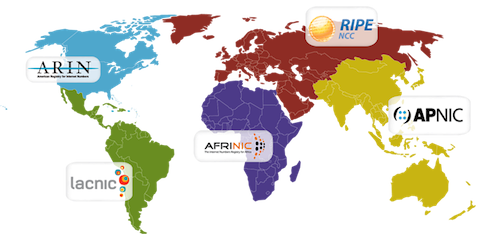History of the Regional Internet Registries
The Internet began as an experimental project that interconnected a small number of research institutions. From the beginning, every device directly connected to the Internet needed an IP (Internet Protocol) address – a unique number that identifies the device and allows it to be located on the network. For the system to work every connected device must have a unique address, so it was important that the allocation of IP addresses was carefully registered to avoid conflicts.
In the beginning, the global IP address registry was simply a list of IP address ranges, along with details of the organizations to which these had been allocated. Of course as more organizations joined the Internet, this list grew. Before long this important role was formalized as IANA – the Internet Assigned Numbers Authority. Even so, the list of organizations continued to grow. So, following the Internet’s rapid expansion across the world, it became clear that even IANA would be unable to scale to meet the demand for addresses or be able to service the wide range of different regional needs. In 1992, the Internet Engineering Task Force (IETF) recommended that Internet number resources be managed by subsidiary organizations at a regional level.
As a result, the Regional Internet Registries (RIRs) were established to assume this regional allocation and management role in cooperation with IANA. Today, there are five RIRs – APNIC, ARIN, RIPE NCC, LACNIC, and AFRINIC.

With the active support of their respective communities, the RIRs have the authority within their regions to administer and register IP address space and Autonomous System numbers and to provide related services.
RIRs operate as industry self-regulatory bodies. Their open structures encourage direct participation by any interested party through consensus-driven, bottom-up decision-making processes. This ensures that those who directly use these numeric Internet resources define the policies that govern their distribution and use. All RIRs are not-for-profit organizations which are entirely self-funded by their Members and those that use the resources.
For over a decade now, this framework has provided a number resources management system that is scalable, effective, stable, open, and fair. This has been critical to the successful growth of the Internet in the past and will ensure its stability into the future.
While RIRs work independently within the regions they serve, they also cooperate and coordinate their activities with each other. Some of this work is done through the Number Resources Organization (NRO), which is a coordinating body that unites the five RIRs.
Read more about how the RIR system was established in, “RIRs: Past, Present, and Future”.
